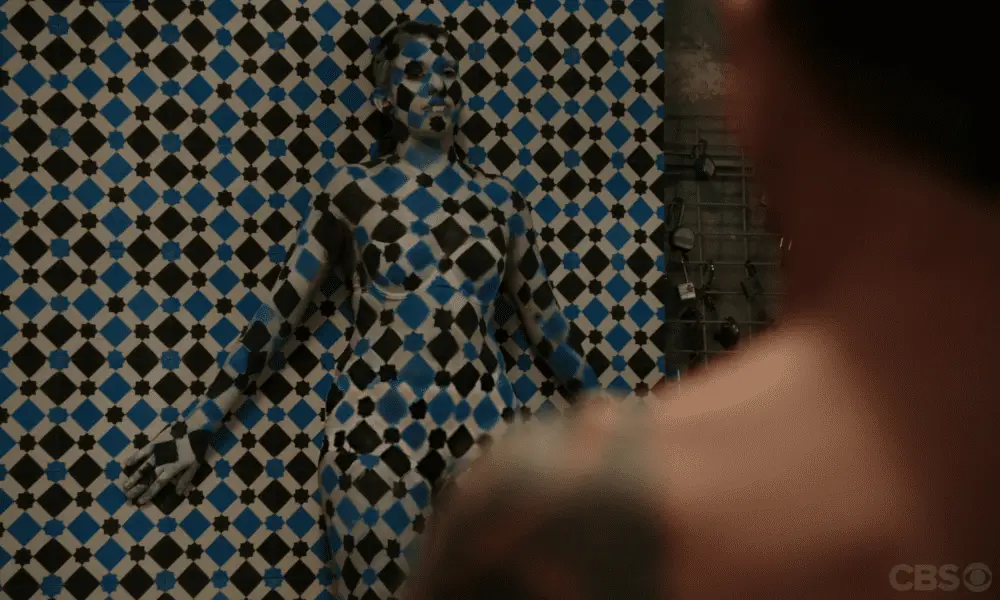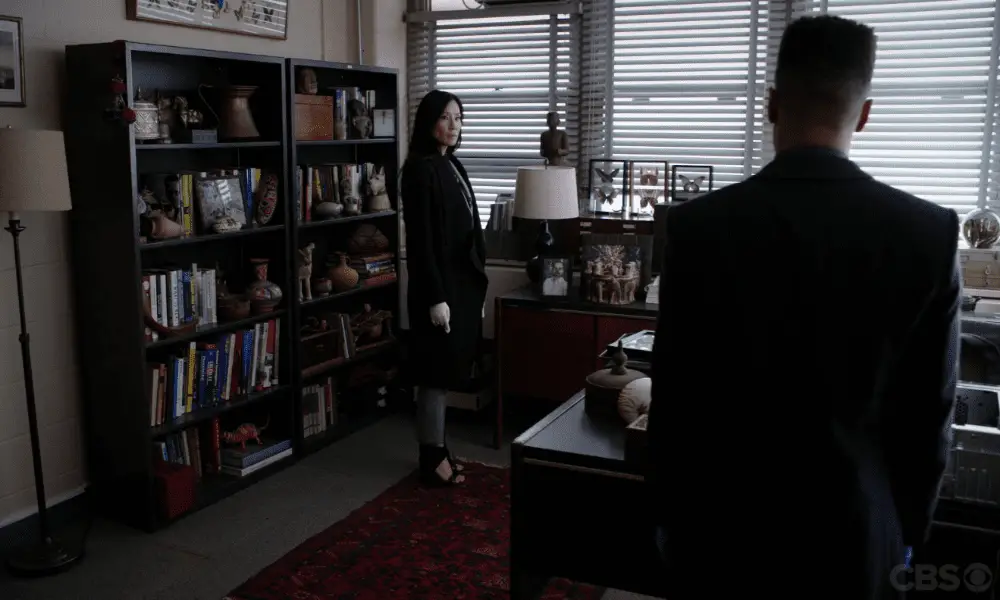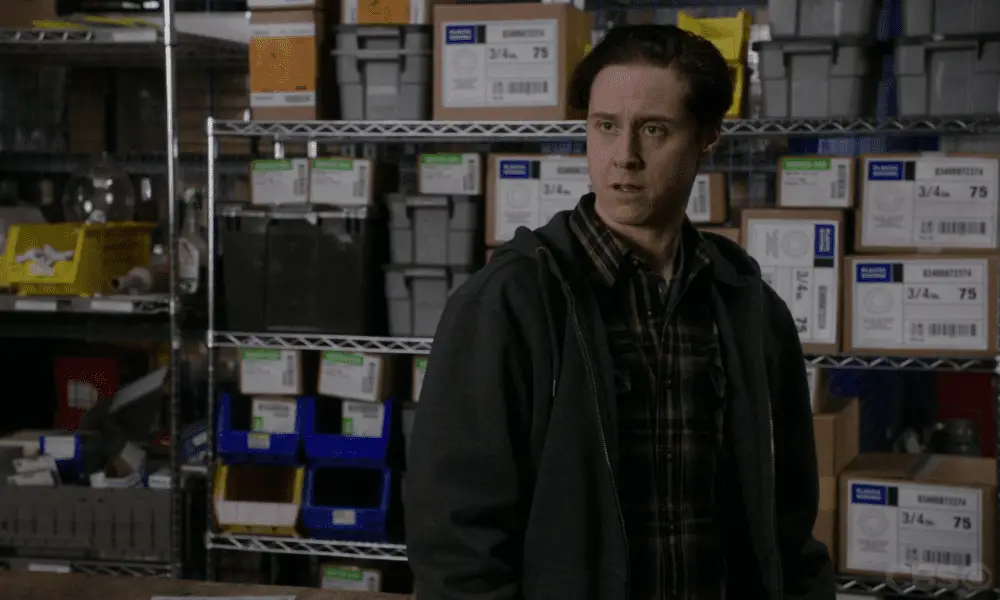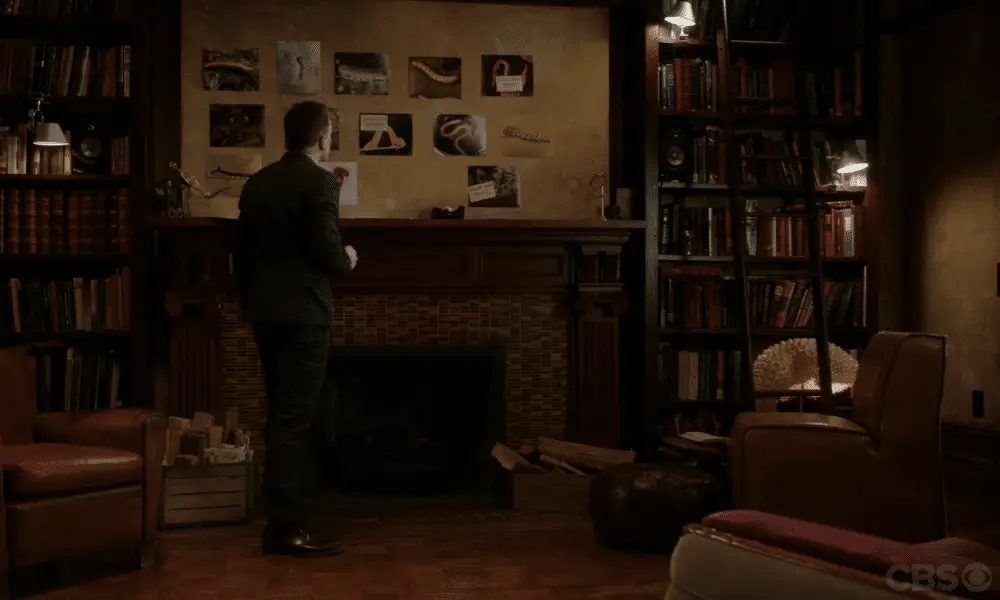Our Elementary this week is very worm-themed, so let’s get the meme out of the way right from the start. Please allow me to say, from the bottom of my heart, “Oh, worm?” Okay. I feel better now. Thank you for your patience.
We begin with Sherlock doing something weird with some of his gal pals. Typical Sherlock stuff. It’s merely a set up for him getting a phone call from his doctor’s office asking him to come in. Naturally, he worries that it’s bad news about his Post Concussion Syndrome, maybe a possible relapse. But his doctor assures him he’s doing fine. No, there’s a different problem. Someone broke into the office and stole all the patient files, including Sherlock’s. He offers to look into it.
Elsewhere in the world, a TA is carrying out a tour of a university’s department of entomology and nematology. That’s the study of worms. I just learned that and now so did you. In a worm composting device thingy, she finds – wait for it – a human corpse. Gasp!
The victim is Dr. William Velnik, an expert in the study of worms who was known as “The Worm Hunter.” Just the sort of name everyone wants to be known by. The cause of death was a sliced carotid. His body was in the composter for nearly a month. Velnik frequently traveled to research worm species, so no one had noticed him missing. His cell phone and hard drive are gone from his office, which suggest to the detectives that he knew his killer. But Velnik had a reputation as a ladies’ man, so that doesn’t really narrow things down.
Velnik was a bit, shall we say, shady. There’s nothing wrong with having multiple partners, but it’s another thing altogether to sleep with married women or your own students. So he paid campus security to swap footage of his lab so that he wouldn’t be caught by the university. The problem is, that now makes it hard for the police to identify his past lovers.

Luckily, Sherlock is on the case. Velnik discovered several new species of worms before he died. That means that he got to name them. Many have odd names. As it turns out, the Latin, translated back into English, holds references to the names of Velnik’s lovers. I can’t decide if that’s sweet or creepy.
The police bring the newly identified women into the office to interview them. A few stand out. One is a fellow professor at the university, Sepi Chamanara. She freely admits her relationship with Velnik. But it was purely sexual and non-monogamous. The night of the murder, she was herself with another woman. But she remembers that another one of Velnik’s lovers wasn’t so chill about things. Becca Mainzer was, in fact, quite jealous.
Ms. Mainzer is married, but she can’t deny that she was in a relationship with Velnik. But she was at home the night Velnik was killed. That’s odd, because campus security footage of the parking lot shows her car was at the university at the time of the murder. If Becca Mainzer wasn’t driving the car, who was?
Her husband. He found out about his wife’s affair. In a jealous rage, he drove to the university. Joan, slightly taken aback, asks if he’s confessing to Velnik’s murder. He sure is! Mr. Mainzer proudly tells them that he stormed into Velnik’s office, shot him three times in the chest, and left his body there.
There’s just one problem. There were no gunshot wounds on Velnik’s body. He died of a wound to the throat. Is it possible that Mainzer shot Velnik but someone else killed him?

Hawes, the ME, re-examines the body. He still doesn’t find any bullet holes, but he does notice three small fractures to the ribs. If Velnik was wearing some sort of bullet-proof vest or ballistic fiber, the fractures could be the only sign of bullet shots.
They do have footage of Velnik entering his lab on the night of his murder. It doesn’t look like he’s wearing a bullet-proof vest. But he is wearing a weird, silvery hoodie that was not found on his body. Maybe that was bulletproof? If so, it would be the thinnest ballistic fiber ever invented. There would be big money in such an important new invention. How does a worm scientist have such a thing?
It’s not as unlikely as it seems. Joan looked into Velnik’s background. Like most scientists, his research was funded by grants. One of these grants came from a company, Hoyt Armor, that was researching ballistic fiber. Nature produces super strong, super thin natural fibers all the time in insects, spiders, and worms. The scientists studying those bugs could be on the forefront of body armor studies.
As Joan follows that lead, Sherlock works on his own case. At a construction site, he finds an Irish man using the name “Sherlock Holmes.” Post-Brexist, job prospects in the UK are rough. So our Irish friend immigrated to the US. But in order to get work, he needed the number of a legal resident. He bought Sherlock’s number off the dark web. Sherlock deduces this all at speed as the Irishman watches in bemusement. He politely hands over the url of the site. Sherlock cheerfully warns him that the name “Sherlock Holmes” comes loaded with it’s own unique dangers and that he may want to use a different one.

Joan and Bell meet with the boss of Hoyt Armor. Velnik was working with the company to try and develop ultra strong and thin ballistic fiber. Joan theorizes that instead of giving the fruit of his labor to Hoyt, Velnik kept his ballistic fiber prototype. Maybe the company found out and killed him for it. But the Hoyt exec has an alibi and he says that they didn’t hire Velnik to make any fiber, just to do research, which was what he did. The exec doesn’t know anything about Velnik making his own fiber. But he understands why Velnik would want such a thing. Someone had been emailing Velnik death threats.
Sherlock is now faced with two computer difficulties. How to track down the source of the death threats and the person that sold Sherlock’s information on the dark net. You know what that means – Mason! In exchange for a favor, Mason gets to work on both issues.
The emails are easier to solve. Mason backtracks them to an unexpected source. Rather than another vengeful lover or other enemy, the emails come from a woman who does…money…stuff. I am only a humble humanities grad who can’t do math so I absolutely could not understand what her job was. Something about investments and buying companies.
Anyway, this woman regularly emails death threats, but not because she actually wishes death on people. The emails are actually viruses that when opened, download all the information off a person’s computer to help her do research for her job. She was contemplating buying Hoyt Armor if the company was close to developing new ballistic fiber. But on downloading Velnik’s research, she found they weren’t close at all. In fact, Velnik had apparently moved on from ballistic fibers and was instead researching pesticide resistant roundworms.
If Velnik and Hoyt weren’t close to ballistic fiber, then where did the hoodie come from? The detectives theorize that Velnik, taking the death threats seriously, stole the hoodie from someone for protection. Then, either the creator of the hoodie or another company that wanted to make the fiber stole it and killed Velnik. So the next question is, who was close to making the fabric?
Sherlock does some of that sweet, sweet research. There are a handful of companies and scientists working on making ultra-thin ballistic fiber. But only one produces a swatch of material as thin and strong as that which Velnik must have been wearing. Orb Lite Lab. Sherlock and Bell pay them a visit.

Orb Lite’s fabric is made from the fibers, not of worms, but a certain kind of spider. But the head scientist there insists that Velnik’s hoodie couldn’t have come from them. Orb Lite may have found a strong fiber, but they can’t mass-produce it yet and couldn’t make enough fabric for even one hoodie.
Sherlock notices that the spiders’ enclosures are locked up tight. The scientist in charge tells him they lost some spiders a year ago. Or were the spiders stolen? No one but the Orb Lite scientists are supposed to have access to their lab, but another employee confesses that the night of the theft, his gal pal was in the lab. As it happens, she has a very familiar name.
It’s Chamanara, the professor the detectives spoke to before. Turns out she didn’t tell them everything. She’s also in the ballistic fiber business. But unlike everyone else, she figured it out. She spliced the DNA of the spiders with silk worms, allowing her to easily mass produce the fiber. It’s proprietary tech, so even if someone stole one of her prototypes to try and replicate it, it wouldn’t matter. They couldn’t profit off it. But Velnik didn’t steal the hoodie anyway. She gave it to him because he told her he was afraid for her life. Once again, it seems like they’re left with no motive, no killer, and no proof.
But among everything Chamanara tells them, Sherlock finds the clue that lets him figure out who the killer is and how to prove it. As always, no spoilers!
Don’t forget, we still have another case. Mason backtracks the dark website to the person selling Sherlock’s information. Sherlock confronts the thief. He’s got a weird story to tell. He didn’t do this on his own. Someone blackmailed him into stealing the files. Specifically, stealing Sherlock’s files. The thief has no clue why.
Sherlock has an idea. Those files reveal something important: Sherlock is recovering well from his PCS. There’s one person in particular that would be interested in that bit of information. He promised he’d stay away so long as Sherlock was sick. So if Sherlock is better…
Michael is back.

Thoughts:
- Why are etymology and entomology are such similar words with such different meanings? Who allowed this?
- This episode’s plot was very twisty and thus hard to summarize. It was quite…serpentine. Perhaps….wormlike.
- I tried to research if ballistic fiber was a real thing but all I found was stuff about Fallout 4. But anyway, shouldn’t it be anti-ballistic fiber? Who allowed this?
- Don’t think I didn’t catch that Hamilton reference.
- I know I’ve said this before but like, what is up with the Elementary writers and the D A R K N E T? They have a fixation. I worry about them.
Images courtesy of CBS

